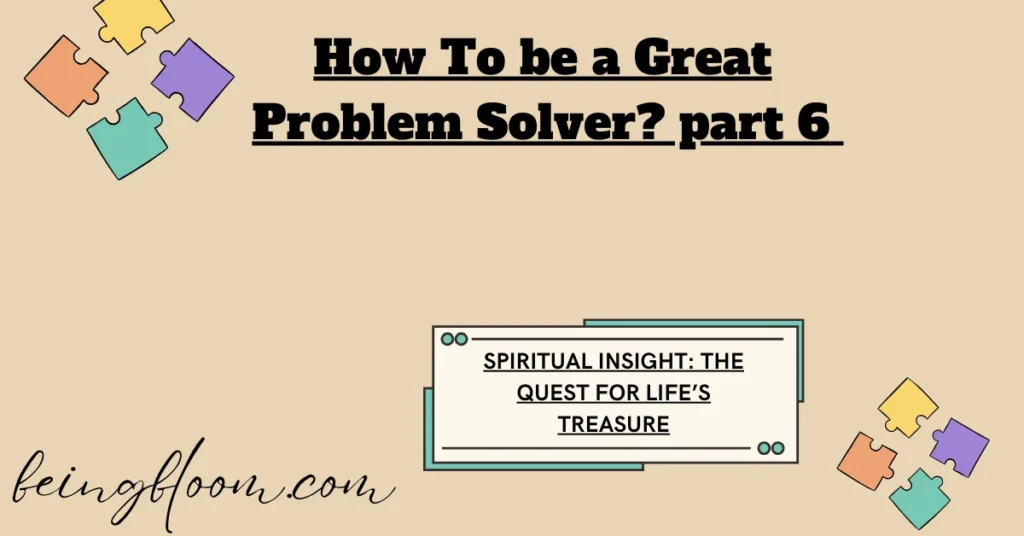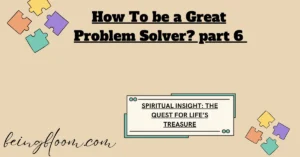
Imagine life as a big adventure game where every challenge is like a treasure map that holds secret clues. Instead of thinking of problems as annoying roadblocks, see them as chances to grow and learn about yourself. Every tough situation is like a hidden gem that shows you something important. It’s like the universe is saying, “Here’s a puzzle for you. Solve it, and you’ll discover something valuable! ” Think of problems as wise teachers. When you face one, ask yourself, “What can I learn from this? ” It might be teaching you to be more patient, strong, or to find a new part of yourself. Every challenge gives you a chance to dig deeper into who you are. This isn’t just about fixing problems; it’s about learning about your spirit. Look at the stories of great spiritual figures. Before Buddha reached enlightenment, he went through many challenges. His journey was filled with hardships that helped him find important truths about life. Similarly, Nelson Mandela spent many years in prison, but this experience wasn’t just punishment—it changed how he viewed justice and leadership.
Solving problems leads to moments when you understand yourself better. It’s like discovering a secret room inside a treasure chest. The happiness comes not only from overcoming the issue but also from the growth you experience along the way. Dealing with challenges helps you see things more clearly, making the journey just as important as where you end up.
Apply the lessons learned:
Use these spiritual ideas as helpful rules when facing problems. When you come across a challenge, remember—it’s not just about fixing it, but also about what you learn along the way. Think about the lessons you discover and how they help you grow. This way of thinking turns problems from being just stressful into chances to learn. Each difficulty gets you closer to your spiritual treasure. Celebrate the growth and insights you gain by overcoming problems, and realize that you are always moving towards greater spiritual awareness. By looking at problems with this spiritual perspective, you can turn every struggle into a step toward better understanding and personal happiness. So, when life presents you with a challenge, welcome it as part of your spiritual journey. Solve the puzzle, find the treasure, and enjoy becoming the best version of yourself.
Practical Tips and Exercises:
Your everyday problems are like a workout for your brain—they make it stronger and smarter! Just like lifting weights builds your muscles, using these tools can help you improve your problem-solving skills. With practice, you can handle even the hardest challenges.
1. Fishbone Diagram:
The Fishbone Diagram is your guide for solving problems. It helps you lay out the problem and see what might be causing it. Each “bone” represents a possible reason. Organize these into groups to figure out where the problem is.
For instance, if your project is not finished on time, you could have categories like People, Process, Materials, and Environment. Under People, you might write “Poor communication,” and under Process, you could write “Slow workflow. “
2. Mind Mapping:
Think of your brain as a big web. Mind mapping helps you see how different ideas link together, making it simpler to spot patterns and come up with answers. Begin with the main issue in the middle and branch out with thoughts, reasons, and solutions. This becomes your area for solving problems!
Example: Main issue: More work to do. Branches: Sharing tasks, managing time better, hiring more workers.
3. SWOT Analysis:
A SWOT Analysis is like a tool for solving problems. It helps you figure out the Good things, Bad things, Chances, and Risks connected to a problem. It’s a smart method that clearly shows what’s working and what isn’t.
Example: Issue: Starting a new product.
Good things: Unique design, strong brand name.
Bad things: Small money for advertising.
Chances: Increased demand in the market.
Risks: Competing products.
4. Brainstorming Sessions:
Get your team or friends together for a brainstorming session. Let everyone share their ideas freely—no idea is too wild. The more unusual, the better. Often, the craziest thoughts lead to the best answers.
Example: Issue: Not enough customer interest.
Brainstorming ideas: Fun social media contests, rewards for loyal customers, creative ads.
5. Root Cause Analysis:
Look deep into the problem like a treasure hunter. Root Cause Analysis helps you see why a problem happened and how to stop it from happening again. It’s like solving a puzzle—once you find the missing piece, everything makes sense.
Example: Issue: Not enough skilled workers.
Root causes: Few chances for job growth, poor training, lower motivation in workers than in private companies.
Your Daily Problem-Solving Workout:
Like your exercise routine, try to regularly use these tools. The more you practice, the better you’ll get at solving problems. Make them a part of your daily routine and notice how you change in facing challenges. So grab your superhero tools and start working. With these tools, you can tackle any issue. Enjoy the fun of finding solutions!
Reflection and Overview:
Now, fellow travelers on this journey, let’s take a moment to think about our exciting adventure. Remember, problems are not the bad guys in our story. Instead, they’re the unexpected turns that make our personal journey more exciting.
We’ve learned that problems are like surprising twists on a roller coaster—unexpected, sometimes a bit scary, but always thrilling! Each problem is a chance to grow, improve your skills, and discover new things about yourself.
Every challenge is an invitation to a grand adventure where you are the hero, and creativity, determination, and smart planning are your tools. We’ve practiced dealing with problems, thinking for ourselves, and using logical reasoning. We’ve broken down issues with First Principles Thinking, explored deeply with the 5 Whys, and mapped out causes and effects with the Fishbone Diagram.
And don’t forget how fun it is to solve problems! After every tough journey, there is a reward waiting for you. That reward is the answer to the problem. When you solve problems, your brain gets a little boost of happiness from dopamine, which feels like a win. So, take time to celebrate every little success—even when you find out why your socks keep disappearing. In this big journey of life, welcome every challenge. Approach them like a brave explorer or a heroic character. Each challenge gives you a chance to improve, to learn new things, and to make your story even more exciting and meaningful.
So keep in mind: problems aren’t a dead end, but rather surprising turns that add excitement and possibilities to your adventure. Embrace them, tackle them with energy, and fill your journey with joy, learning, and growth.
Keep going on adventures—may your story always include thrilling challenges and happy victories!
Inspirational Message:
Here’s one more piece of advice to inspire you. The next time you run into a problem, remember: you’re not just fixing it—you’re getting ready for your next big adventure. Think of each problem as a cool twist in your personal story. Every challenge is a new part, opening paths to new chances. Really embrace it, like finding a secret path in a game you love. In life, you might feel annoyed, tired, or even like you’re carrying heavy burdens. But honestly, it’s these challenges that make your journey unforgettable. They test what you can do, sharpen your plans, and give you moments of success during tough times.
So next time you’re facing a problem, don’t just solve it—celebrate it. View it as a chance to grow and show how talented you truly are. Each challenge you overcome doesn’t just add another win to your list—it makes you the hero of your own story.
Keep that playful spirit in your eyes, with creativity burning in your heart, and the will to turn every problem into a stepping stone. Laugh at the messiness, and always remember: every solution is a brand-new story waiting to be lived.
Wishing you all the best for your next amazing adventure!
Action Steps:
Alright, your challenge is set—it’s time to use your new skills! Here’s your challenge: pick one problem you’re facing right now. It can be big or small. Got one? Awesome!
Now, go through the steps we talked about in this lesson:
1. Take a clear look at the problem.
2. Break it down into smaller pieces you can handle.
3. Think of creative solutions.
4. Check out the different choices and pick the best one.
5. Put your solution into action and make changes if needed.
6. And remember to celebrate your success—no matter how small it is!
See how these steps change the way you solve problems. It’s like taking a regular job and making it an exciting adventure. You might be amazed at the happiness and fun you can experience when dealing with difficulties. Keep in mind, this isn’t only about solving issues—it’s about enjoying the real excitement of life. So, jump into your problem, use the method, and see the wonders happen. Your path to becoming a great problem-solver starts right now!
Questions to Think About:
Once you’ve handled that challenge like a true hero, it’s time to think back on what you went through. This is your moment to reflect and celebrate what makes you special. First, ask yourself: How did you feel after you fixed the issue? Did you feel the happiness of winning? Or did you feel your excitement slowly growing as you worked through it? Pay attention to those feelings—they are a valuable part of your personal development.
Next, consider this: What new techniques did you find? Maybe you discovered some smart strategies that will help you with future problems. Keep those in mind. Those feelings and strategies are your new strengths, ready to help you on your next journey.
Always remember: each problem you solve adds to your collection of knowledge. So, take pleasure in these experiences. Think about them. And prepare for whatever challenge comes next. Because every struggle isn’t just an obstacle—it’s a chance to grow, to learn, and most importantly, to enjoy the experience.
“If you’ve jumped straight here, you might miss the essence. Start the journey from the beginning with Part 1: How to Be a Great Problem Solver? – The King of Pop .”







